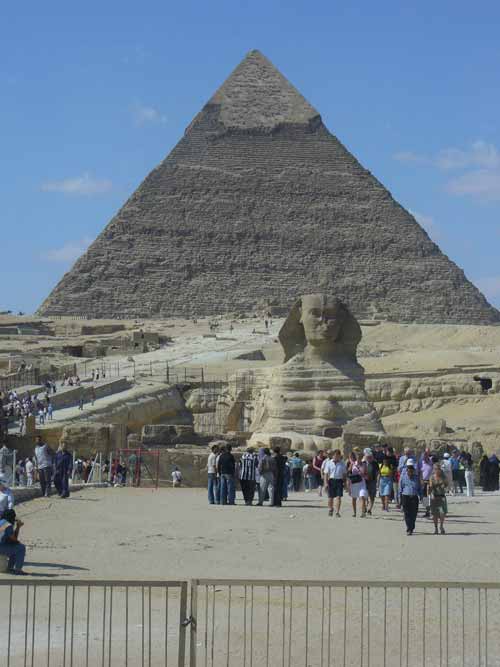TABLE
OF CONTENTS
|
Egypt
By Kristin Trapp
Egypt’s
cities
were much different than I had imagined they would be.
As I looked through the window of the tour
bus, I found the scenery to be almost comical. Seeing
international businesses such as KFC in front of
the Pyramids
made me laugh. Thinking that the main
job of the Sphinx was to protect the pharaohs from the dangers of
Colonel
Sanders and his Wednesday’s all-you-can-eat chicken buffet added a
little
comedy to the scene. I thought about
exploring
some of the other dimensions of a global city that Short and Kim
discuss in
their book Globalization and the City. Most
of them were as easily visible. 
The
first observation that I wanted to make was the way that people,
especially
tourists, immigrants, refugees and guest workers move about a city. This is also known as ethnoscapes, and is the
easiest dimension to observe. However in
this city it was slightly challenging to observe since a good portion
of Egypt’s
population consists of native Arabs, although tourists were prevalent
everywhere. The main tourist groups I
noticed were many British, German, and Asian although I am certain that
there
were many others. As a tourist I felt it
was much easier to travel in Egypt
as opposed to other countries that I visited, because the majority of
the
people spoke English and the street signs were written in English. I couldn’t help but wonder, with all the
people that live in the cities, how well do all these people
communicate with
the rest of the world? The answer to
this was not hard to find.
The distribution
of information by way of newspapers, magazines, TV program and films is
known
as mediascapes and in Egypt
is readily accessible everywhere. Even
though most of them were written in Arabic, of was not a major problem
since
all the information was also available in English.
Information was also very easy to access via
the internet. Internet cafes were not
difficult at all to find. The
observation that I made was that the availability to distribute
information
world wide was present and easily available. This
brought me to my last dimension, finanscapes.
Visiting
the cities in Egypt
really changed my perspective of what I had expected to find. I had always imagined Egypt to have more of a Disneyland
feel, with the entire city being sustained by the tourists that came to
this
fantasy land. I imagined that all the
buildings would be decorated with imitation hieroglyphics and venders
walking
the streets wearing pharaoh costumes. By
looking at the finanscapes I realized just how ridiculous my
presumption was. The city was actually
filled to the brim with
buildings that were unfinished and rundown. Taking
a closer glance would show that the buildings were
not only
occupied but over crowded with multiple families sharing small spaces. This can be better explained by Mike Davis in
his article of "The Prevalence of Slums," where he goes into
great detail
explaining the conditions of the slums, poverty and housing conditions
in
thirty four metropolises. He also
explains that there are four basic shelter strategies that most
citizens of Cairo
use in search of
shelter. The first is to search for
shelter that is central to the job market, second, find a location that
is
centrally located as well but is an informal shelter, third squat on
publicly
owned land and the last and most common strategy used, buy a house
without
official building authorization. I also
learned an interesting fact from Davis
about the buildings that appeared to be unfinished; most of them were
left
unfinished intentionally because unfinished buildings are not taxed.
Egypt
was very
interesting to visit. The diversity that
was present really amazed me. The
history was by far my favorite attribute of the country.
Witnessing history in almost the same
condition it was in the day it was created fascinated me and seeing it
being
integrated with a very modern and up to date society was something that
I was
pleasantly surprised with.
|

